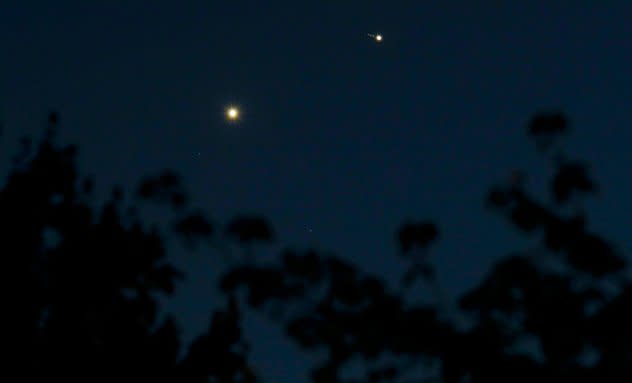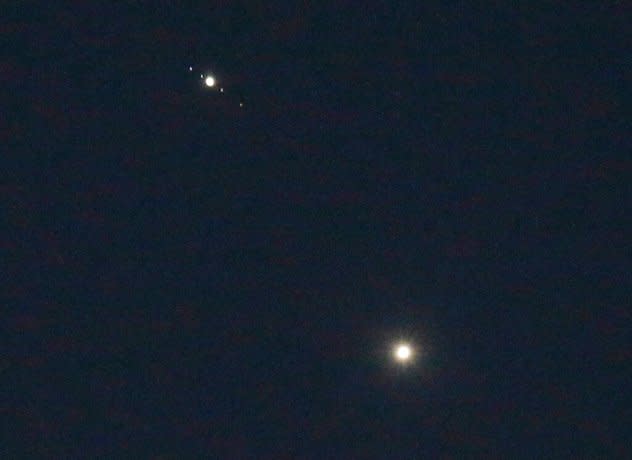Spring star: Planetary duo to shine in night sky as the season changes
Venus and Jupiter stole the celestial spotlight last week when they aligned with the crescent moon on three consecutive nights. The planetary duo will once again be the highlight of the night sky this week as they appear incredibly close, an astronomical meetup known as a conjunction.
The convergence of Jupiter and Venus this week will be akin to the "Christmas star" on Dec. 21, 2020, when Jupiter and Saturn appeared to shine together just four nights before Christmas. Because of the similarities, this week's conjunction can be considered the "spring star" as the tight-knit pairing of Jupiter and Venus will take place on the first night of meteorological spring, which starts on March 1 every year. This differs from astronomical spring, which begins roughly three weeks later on the equinox.
 |
The planets Venus, left, and Jupiter, right, with three of its moons visible, appear close to each other in the sky above tree branches after dusk Wednesday, July 1, 2015, in Tacoma, Wash. In reality, the planets are millions of miles apart, but to viewers from Earth they have appeared very close together recently. (AP Photo/Ted S. Warren) |
The distance between the two planets in the sky on Wednesday evening will be smaller than the width of a pinky finger held at arm's length. However, this is just from the perspective of the Earth. In reality, they will be separated by more than 400 million miles.
 |
Stargazers of all ages will be able to pick out Venus and Jupiter easily in the western sky without a telescope, but having a telescope or a pair of binoculars can make the pairing an even more impressive sight.
On June 29, 2015, Jupiter and Venus converged in a similar fashion to what will take place on Wednesday. During that event eight years ago, people who set up a telescope were able to see the planets in the same field of view. Most telescopes can also reveal Europa, Io, Ganymede and Callisto -- the four largest moons that orbit Jupiter.
 |
The planets Venus, bottom, and Jupiter, top center, light the sky above Matthews, N.C., Monday, June 29, 2015. The two brightest planets appeared to be unusually close together. (AP Photo/Chuck Burton) |
Venus and Jupiter will remain prominent planets in the evening sky throughout March, but with each passing night, they will appear farther apart.
Another good night for viewing the planets will be on March 23, when the crescent moon appears nearby in a similar event to the late February alignment.
Want next-level safety, ad-free? Unlock advanced, hyperlocal severe weather alerts when you subscribe to Premium+ on the AccuWeather app. AccuWeather Alerts™ are prompted by our expert meteorologists who monitor and analyze dangerous weather risks 24/7 to keep you and your family safer.



